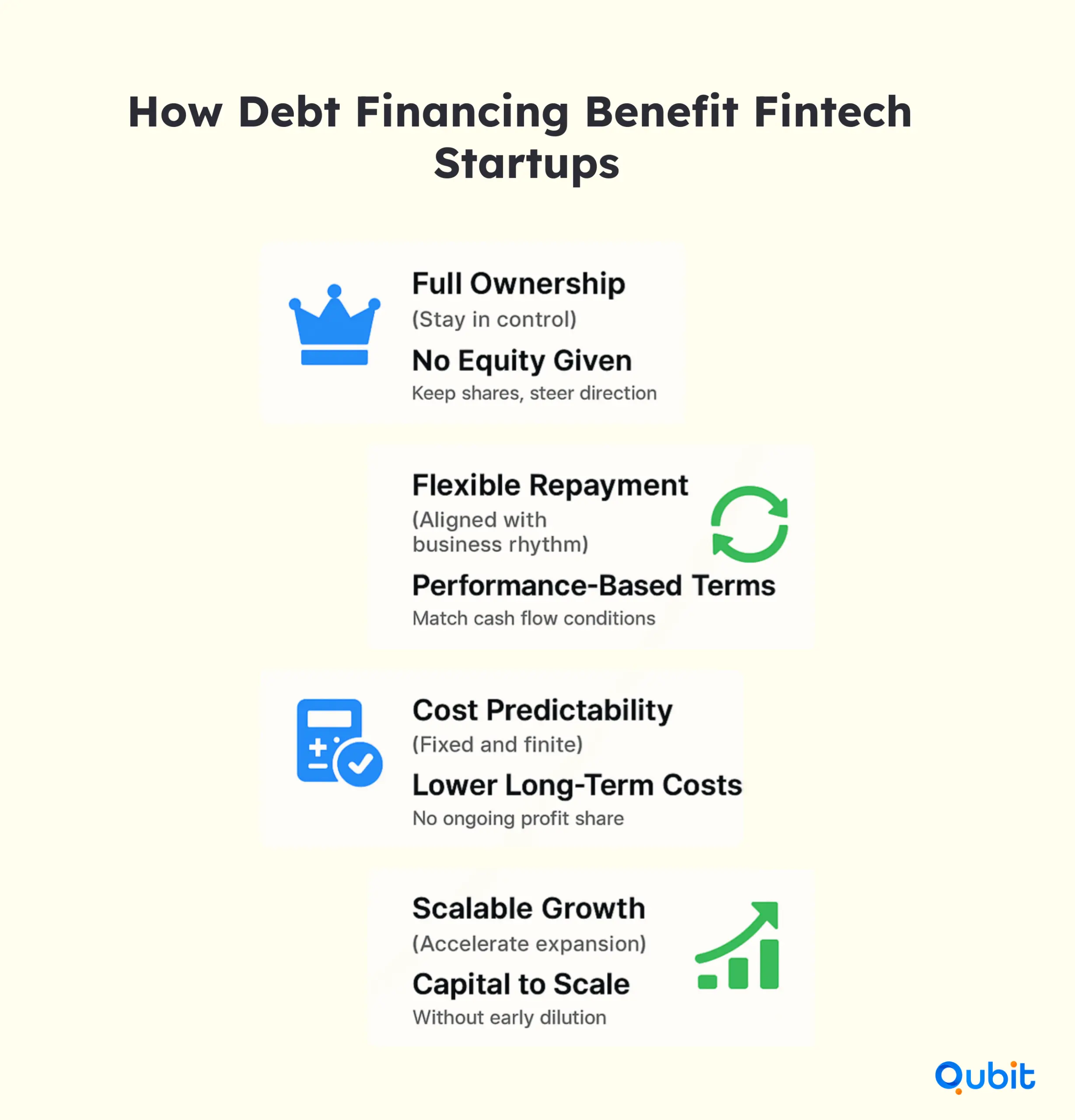FinTech start-ups often face unique challenges when securing funding, especially in their early stages. Debt financing emerges as a pivotal option, offering founders the ability to access capital without diluting equity. Initially, founders can explore the strategic blend of equity and debt financing to optimize their capital structure. This approach allows businesses to maintain control while fueling growth.
This discussion of debt financing options finds additional context in fintech fundraising strategies and opportunities, offering you a broader perspective on diverse funding approaches.
In this article, we aim to demystify debt financing options and explore how FinTech start-ups can strategically combine equity and debt to scale effectively. Let’s jump right in!
How Debt Financing Benefit Your Fintech Startup
Debt financing offers FinTech companies a strategic way to secure capital without sacrificing ownership. Unlike equity financing, which dilutes control, debt allows founders to maintain their stake while accessing funds to fuel growth. This approach is particularly advantageous for businesses aiming to scale while preserving decision-making authority.

Retain Ownership and Control
One of the most compelling benefits of debt financing is the ability to retain full ownership. By opting for debt instead of equity, founders avoid giving up shares in their company. This ensures that strategic decisions remain in their hands, fostering long-term alignment with the company’s vision.
Flexible Repayment Structures
Debt financing can be tailored to align with a company’s cash flow, making repayments manageable during fluctuating revenue periods. For example, venture debt often includes repayment terms that adjust based on the borrower’s financial performance, ensuring that businesses can prioritize growth without undue financial strain.
The analysis gains depth when considering revenue based financing fintech, which presents a model where repayments adjust in line with your business’s earnings. This alternative financing model complements traditional debt instruments by offering even greater flexibility.
Lower Costs Compared to Equity Financing
Debt financing typically incurs lower costs over time compared to equity financing. While equity requires sharing profits indefinitely, debt involves fixed repayments, allowing businesses to forecast expenses more accurately. This cost efficiency makes debt an attractive option for FinTech companies focused on scaling sustainably.
Scalable Solutions for Growth
Venture debt serves as a scalable solution during critical growth stages. It provides the necessary capital to expand operations, enter new markets, or invest in technology without the need for immediate profitability. Expert insights suggest that venture debt is particularly effective for companies with predictable revenue streams, as it bridges the gap between funding needs and long-term financial goals.
Debt financing is not just about securing funds; it’s about enabling FinTech companies to grow strategically while maintaining control, flexibility, and cost efficiency.
Potential Risks of Debt Financing
Debt financing can offer FinTech companies a pathway to growth, but it comes with significant risks that must be carefully managed. One of the primary concerns is the burden of fixed financial obligations. Unlike equity financing, debt requires regular repayments regardless of the company’s revenue performance. This can strain cash flow, especially for startups or businesses experiencing fluctuating income.
Another risk lies in the potential impact on credit ratings. If a FinTech fails to meet its repayment schedule, it could face downgrades in its creditworthiness, making future borrowing more expensive or even inaccessible. This can create a cycle where financial flexibility diminishes over time, limiting opportunities for expansion or innovation.
Economic downturns amplify these risks. During periods of reduced consumer spending or market instability, FinTechs may encounter liquidity pressures that make debt repayment challenging. This exposure can lead to operational disruptions or, in extreme cases, insolvency.
For risk mitigation, consider supplementing debt with publicly supported options. A closer look at fintech government grants illustrates public funding initiatives that can work in tandem with traditional debt approaches. These grants can provide a financial cushion, reducing reliance on debt and its associated risks.
Understanding these potential pitfalls is crucial for FinTechs aiming to balance growth ambitions with financial stability.
Benefits of the Equity and Debt Staircase Approach
Balancing equity and debt in a startup’s financial strategy can unlock significant advantages. The equity and debt staircase approach, a hybrid funding model, minimizes dilution while distributing financial risk effectively. This method not only extends a startup’s financial runway but also enhances its credibility with investors and provides flexibility in valuation.
Reducing Dilution While Retaining Control
One of the standout benefits of this approach is its ability to limit equity dilution. By incorporating debt strategically, founders can secure necessary capital without relinquishing excessive ownership. This ensures that the startup’s long-term vision remains aligned with its original goals, as founders retain greater control over decision-making.
Distributing Financial Risk
Combining equity and debt also spreads financial risk across multiple funding sources. Equity investments provide long-term stability, while debt financing offers immediate liquidity without impacting ownership. This balance creates a more resilient financial structure, safeguarding the business during market fluctuations or unforeseen challenges.
Enhancing Investor Confidence
A well-structured hybrid model signals financial prudence to potential investors. It demonstrates that the startup is not overly reliant on a single funding source, which can be a red flag. Instead, this approach showcases a thoughtful strategy that prioritizes sustainability and growth. For a deeper dive into alternative funding strategies, you can compare with alternative funding for fintech, which explores options like crowdfunding, venture debt, and private equity.
Extending the Financial Runway
By carefully integrating debt into the funding mix, startups can stretch their financial resources further. This extended runway allows businesses to achieve critical milestones before seeking additional equity funding, often at a higher valuation.
The equity and debt staircase approach is a powerful tool for startups aiming to optimize their financial strategy. By blending the strengths of both funding types, it ensures a balanced, sustainable path to growth.
Accounting and Technical Considerations
Managing complex capital structures demands a thorough understanding of accounting principles and technical requirements. From revenue recognition to regulatory compliance, each aspect plays a critical role in ensuring financial accuracy and transparency.
Revenue Recognition Challenges
Revenue recognition often becomes a focal point when dealing with intricate capital structures. For example, startups may face hurdles in accurately recording revenue from multi-year contracts or subscription-based models. This approach ensures that financial statements align with accounting standards and provide a clear picture of the company’s financial health.
Adhering to regulatory requirements is another critical consideration. Companies must stay updated on evolving laws and standards, such as those related to debt modifications or equity arrangements. Failure to comply can lead to penalties or reputational risks. Implementing robust compliance frameworks and consulting with experts can help mitigate these challenges effectively.
Modifications in Debt Terms
Debt restructuring or modifications often require careful accounting treatment. Changes in interest rates, repayment schedules, or covenants can impact financial reporting and tax obligations. Companies must evaluate these adjustments meticulously to avoid discrepancies in their balance sheets.
Conclusion
A thoughtful blend of equity and debt financing can be transformative for FinTech startups aiming to scale effectively. By adopting a stage-wise approach, businesses can align their funding strategies with growth milestones while maintaining a balanced risk profile. This method not only supports sustainable expansion but also ensures that the capital structure remains adaptable to market dynamics.
Implementing best practices, such as diversifying funding sources and seeking expert financial guidance, further enhances the ability to manage risks and optimize resources. Targeted financial tools tailored to the unique needs of FinTech companies can play a pivotal role in achieving these goals.
If you're ready to optimize your funding strategy, we at Qubit Capital are here to assist with our comprehensive Fundraising Assistance service. Let us help you build a robust financial foundation for your FinTech venture.
Key Takeaways
- Stage-wise equity and debt financing optimizes capital structure while limiting dilution.
- Debt financing offers scalable capital without compromising control.
- A balanced hybrid model mitigates risks and leverages growth opportunities.
- Specialized banking tools are essential for effective cash management.
Frequently asked Questions
What is fintech debt financing?
Fintech debt financing lets startups borrow capital from online platforms or non-bank lenders, often with faster approvals and transparent rates. For example, a small business might use a peer-to-peer lender to bridge cash-flow gaps within 24 hours.


 Back
Back



